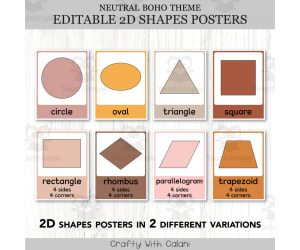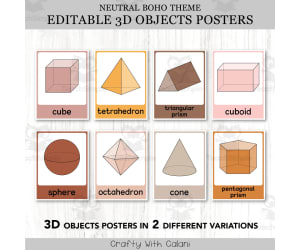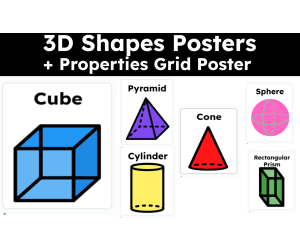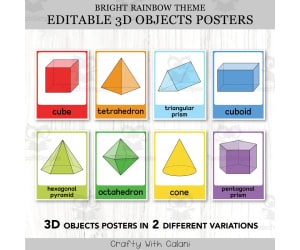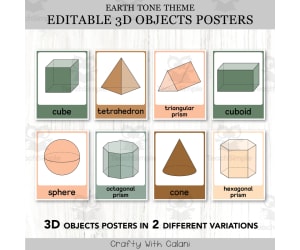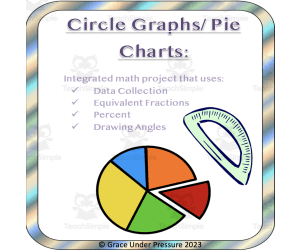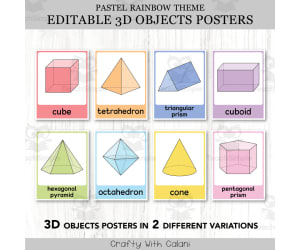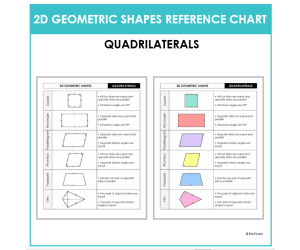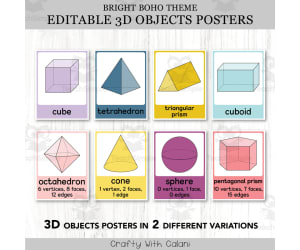2,825 products added recently
Geometry Charts
Geometry Charts provide visual representations of geometric concepts, including different types of shapes, properties of angles, and formulas for area and perimeter. By incorporating these charts, you make abstract concepts more concrete, aiding students in visualizing and comprehending spatial relationships.
2D Shapes Posters, Geometry Math Decor in Neutral Boho Design
Math, Geometry, Grade 1, 2, 3, 4, 5, Teacher Tools, Charts, Classroom Decor, Posters, Templates, Anchor Charts
Improve your classroom’s math comprehension in basic geometry with our 2D Shape Posters in Neutral Boho Design Our 2D shapes charts are informative & visually appealing, It will brighten up your classroom while reinforcing basic geometry concepts. Designed with a neutral boho color tones, these printable 2D shape charts will be a perfect calming and functional addition to your classroom wall. A perfect classroom math decoration to get your students’ excited about learning basic geometry shapes . The set comes in 2 different styles , with and without attributes, gives you options to choose which one is more applicable for your students’ ability. An editable 2D shape posters version is included, make it easier to transform this poster into other languages. It is a perfect addition for bilingual and ESL classrooms 2D shapes included in this posters set: circle oval triangle square rectangle rhombus pentagon hexagon heptagon octagon nonagon decagon parallelogram trapezium/trapezoid obtuse-angles triangle isoceles triangle right-angled triangle acute-angled triangle scalene triangle kite crescent arrow heart star semicircle cross How to incorporate these posters into lessons ♥ Math Wall Displays – Use these times table posters on math bulletin boards for easy reference. ♥ Group Activities – Use them for group work to support collaborative learning. ♥ Individual Practice – Print them smaller and use as flashcards or desk references for independent practice. What will you get ♥ All documents in ready to print pdf formats and come in 2 different paper standards , US ANSI & International paper. ♥ 2 styles of 2D shapes posters , with and without attributes ♥ Editable Microsoft PowerPoint , ideal for bilingual classroom ♥ an ink-friendly black & white version . Print them on colored paper for a vibrant look while keeping it ink friendly.
Author Crafty with Calani
Rating
Tags Home School Poster, Math Poster, Preschool Poster, Math Classroom Decor, 2d Shapes Poster, 2d Shapes Charts, 2d Shapes Flashcards, Geometry Math Display, Neutral Boho 2d Shapes Posters, Neutral Boho Classroom Decor
2D Geometric Shapes Poster & Reference Chart | Triangles
Geometry, Math, Grade 3, 4, 5, 6, Anchor Charts, Teacher Tools, Charts, Diagrams, Graphic Organizers, Posters, Classroom Decor
2D Geometry Shapes Triangles Reference Chart Learning about triangles doesn’t have to be tricky. This reference chart makes it easy for students to understand the different types of triangles, including acute, right, and obtuse angles, as well as equilateral, isosceles, and scalene sides. The chart comes in a full-color version that works beautifully as a classroom wall display, on a whiteboard, or even projected digitally. There is also a black-and-white version that fits perfectly in student binders or interactive notebooks, providing a handy reference sheet that students can keep at their desks. This resource is ideal for lessons on 2D shapes and triangle classification. It’s especially helpful for visual learners who benefit from seeing concepts clearly illustrated, and it makes a useful addition to math centers, classroom displays, or study materials. Using the chart regularly can help students build confidence in recognizing and naming different triangle types while reinforcing key geometry vocabulary and concepts. Teachers will also appreciate the time saved, since the chart is ready to print and use immediately. It works best for students in grades 3 through 6, but it can also serve as a helpful review tool for older students. Whether you display the color chart on your math wall or provide the black-and-white version for individual students, this reference chart is a flexible and practical resource for any geometry unit.
Author EduStudio
Rating
Tags Triangles, Geometry, 2D Shapes, Math Reference Chart, Types Of Triangles, Geometry Poster, Math Classroom Decor, Triangle Classification, Geometry Anchor Chart, Math Visual Aid
3D Objects Posters, Geometry Math Decor in Neutral Boho Design
Math, Geometry, Kindergarten, Preschool, Grade 1, 2, 3, 4, 5, Teacher Tools, Charts, Classroom Decor, Posters, Templates, Anchor Charts
Improve your classroom’s math comprehension in basic geometry with our 3D Objects Posters in Neutral Boho Design Our 3D Objects charts are informative & visually appealing, It will brighten up your classroom while reinforcing basic geometry concepts. Designed with a neutral boho color tones, these printable 3D objects charts will be a perfect calming and functional addition to your classroom wall. A perfect classroom math decoration to get your students’ excited about learning basic geometry shapes . The set comes in 2 different styles , with and without attributes, gives you options to choose which one is more applicable for your students’ ability. An editable 3D Objects posters version is included, make it easier to transform this poster into other languages. It is a perfect addition for bilingual and ESL classrooms 3D Objects included in this posters set: cube tetrahedron square pyramid hexagonal pyramid octahedron triangular prism cuboid pentagonal prism hexagonal prism octagonal prism cone cylinder sphere ellipsoid hemisphere How to incorporate these posters into lessons ♥ Math Wall Displays – Use these times table posters on math bulletin boards for easy reference. ♥ Group Activities – Use them for group work to support collaborative learning. ♥ Individual Practice – Print them smaller and use as flashcards or desk references for independent practice. What will you get ♥ All documents in ready to print pdf formats and come in 2 different paper standards , US ANSI & International paper. ♥ 2 styles of 2D shapes posters , with and without attributes ♥ Editable Microsoft PowerPoint , ideal for bilingual classroom ♥ an ink-friendly black & white version . Print them on colored paper for a vibrant look while keeping it ink friendly.
Author Crafty with Calani
Rating
Tags Home School Poster, Math Poster, Preschool Poster, Math Classroom Decor, Geometry Math Display, 3D Objects Posters, 3D Objects Charts, 3D Objects Flashcards, Neutral Boho 3D Objects Posters, Neutral Boho Math Display
3D Shapes Posters + Properties Grid Poster
Math, Geometry, Elementary, Middle School, Posters, Classroom Decor, Charts, Teacher Tools, Anchor Charts, Diagrams
This file comes as a PDF. It is 20 pages. Includes are three sections. Section 1- includes six colorful and bright 3d shape posters with their names. Section 2- includes six colorful and bright 3d shape posters with their names + each shape's properties (face, edge, vertices) Section 3- is a big grid made up of four 8.5"x11" sheets of paper. You glue the four sheets together to make a big poster. The poster displays a grid with all of the 3d shapes includes and their properties. #math #3dshapes #3dshapeposters - - - - - - - - - - - - - - - - - - - - - - - - - - - - - - - - - - - - - - - - - - - - - - - - - - - - - - - - - - - - - - - - - - - - - - - - - - - - - - - - - - - - - - - - - - - - - - - - - - - - - - - - - - - - - - - - - - - - - - - - - - - - - - - - - - - - - - - - - - - - - - - - - - - - - - - - - - - - - - - - - - - - - - - - - - - - - - - - - - - - - - - - - - - - - - - - - - - - - - - - - - - - - - - - - - - - - - - - - - - - - - - - - - - - - -
Author CraftEdPrints
Tags 3dshapes, 3dshapeposters, 3dposters, 3dshapeproperties, Geometry, 3danchorcharts
3D Objects Posters, Geometry Math Decor in Bright Rainbow Design
Math, Geometry, Kindergarten, Preschool, Grade 1, 2, 3, 4, 5, Teacher Tools, Charts, Classroom Decor, Posters, Templates, Anchor Charts
Improve your classroom’s math comprehension in basic geometry with our 3D Objects Posters. Our 3D Objects charts are informative & visually appealing, It will brighten up your classroom while reinforcing basic geometry concepts. Designed with a bright rainbow color tones, these printable 3D objects charts will be a perfect vibrant and functional addition to your classroom wall. A perfect classroom math decoration to get your students’ excited about learning basic geometry shapes . The set comes in 2 different styles , with and without attributes, gives you options to choose which one is more applicable for your students’ ability. An editable 3D Objects posters version is included, make it easier to transform this poster into other languages. It is a perfect addition for bilingual and ESL classrooms 3D Objects included in this posters set: cube tetrahedron square pyramid hexagonal pyramid octahedron triangular prism cuboid pentagonal prism hexagonal prism octagonal prism cone cylinder sphere ellipsoid hemisphere How to incorporate these posters into lessons ♥ Math Wall Displays – Use these times table posters on math bulletin boards for easy reference. ♥ Group Activities – Use them for group work to support collaborative learning. ♥ Individual Practice – Print them smaller and use as flashcards or desk references for independent practice. What will you get ♥ All documents in ready to print pdf formats and come in 2 different paper standards , US ANSI & International paper. ♥ 2 styles of 2D shapes posters , with and without attributes ♥ Editable Microsoft PowerPoint , ideal for bilingual classroom ♥ an ink-friendly black & white version . Print them on colored paper for a vibrant look while keeping it ink friendly.
Author Crafty with Calani
Rating
Tags Home School Poster, Math Poster, Preschool Poster, Math Classroom Decor, Geometry Math Display, 3D Objects Posters, 3D Objects Charts, 3D Objects Flashcards, Bright Rainbow 3D Objects Poster, Bright Rainbow Math Display
3D Objects Posters, Geometry Math Decor in Earth Tone Design
Math, Geometry, Kindergarten, Preschool, Grade 1, 2, 3, 4, 5, Teacher Tools, Charts, Classroom Decor, Posters, Templates, Anchor Charts
Improve your classroom’s math comprehension in basic geometry with our 3D Objects Posters in Earth Tone Design Our 3D Objects charts are informative & visually appealing, It will brighten up your classroom while reinforcing basic geometry concepts. Designed with an earth tone color tones, these printable 3D objects charts will be a perfect calming and functional addition to your classroom wall. A perfect classroom math decoration to get your students’ excited about learning basic geometry shapes . The set comes in 2 different styles , with and without attributes, gives you options to choose which one is more applicable for your students’ ability. An editable 3D Objects posters version is included, make it easier to transform this poster into other languages. It is a perfect addition for bilingual and ESL classrooms 3D Objects included in this posters set: cube tetrahedron square pyramid hexagonal pyramid octahedron triangular prism cuboid pentagonal prism hexagonal prism octagonal prism cone cylinder sphere ellipsoid hemisphere How to incorporate these posters into lessons ♥ Math Wall Displays – Use these times table posters on math bulletin boards for easy reference. ♥ Group Activities – Use them for group work to support collaborative learning. ♥ Individual Practice – Print them smaller and use as flashcards or desk references for independent practice. What will you get ♥ All documents in ready to print pdf formats and come in 2 different paper standards , US ANSI & International paper. ♥ 2 styles of 2D shapes posters , with and without attributes ♥ Editable Microsoft PowerPoint , ideal for bilingual classroom ♥ an ink-friendly black & white version . Print them on colored paper for a vibrant look while keeping it ink friendly.
Author Crafty with Calani
Rating
Tags Home School Poster, Math Poster, Preschool Poster, Math Classroom Decor, Geometry Math Display, 3D Objects Posters, 3D Objects Charts, 3D Objects Flashcards, Earth Tone 3D Objects Posters, Earth Tone Math Display
Perimeter, Area, and Volume Anchor Charts | Measurement Math Notebook
Common Core, Math, Geometry, Grade 4, 5, 6, 7, 8, Charts, Teacher Tools, Anchor Charts, Posters, Classroom Decor
Perimeter, Area, and Volume Anchor Charts | Measurement Math Notebook Make measurement easy to understand with this clear and visual math anchor chart. It’s designed to help students review and remember key concepts like perimeter, area, and volume through simple examples they can relate to—such as fences, grassy fields, and boxes. The visuals and formulas work together to show how measurement connects to real-life situations in a way that sticks. This printable page also features both customary and metric units for length, weight, and liquid volume, giving students a complete reference they can use throughout their measurement lessons. It’s ideal for math notebooks, classroom walls, or as extra homework support. The chart comes as a full-color page that fits neatly into standard 8.5" x 11" binders or smaller composition notebooks when printed to size. Teachers can use it as part of a measurement or geometry unit, while students can keep it in their notebooks as a quick, reliable guide. File type: PDF
Author EduStudio
Rating
Tags Measurement Anchor Chart, Perimeter Area Volume, Math Reference Sheet, Geometry Notebook Page, Customary And Metric Units, Fifth Grade Math, Classroom Wall Poster, Math Interactive Notebook, Area And Perimeter Formula, Volume Of Rectangular Prism
Dinosaur Shape Hunt Pocket Chart Game
Math, Geometry, Kindergarten, Preschool, Charts, Teacher Tools
Dinosaur Shape Hunt Pocket Chart Game Delve into an engaging world of shapes and letters with the Dinosaur Shape Hunt Pocket Chart Game. This learning resource is uniquely designed to promote students' letter and shape identification skills. It is easy-to-use, hassle-free, and aligns perfectly to the curriculum needs of preschoolers and kindergarteners. Presented as a PDF format with 11 printable pages, this game includes activity cards and a title cover with directions for storage bin usage. Each card showcases bright illustrations in both color and black-and-white versions to cater for different printing needs or visual preferences. The game fits seamlessly into any dinosaur thematic unit or even general lessons on language development or geometry. Usage: Implementing the Dinosaur Shape Hunt Pocket Chart Game adds a fun twist to classroom activities whether in whole group settings, small group centers or as part of homework assignments. The captivating nature of this game ensures that learners remain actively engaged while sharpening their letter recognition, sound association skills as well as shape familiarity. With minor preparation required such as printing, cutting out shapes, laminating for durability then storing conveniently under your easel in Ziploc bags - it couldn't be simpler! The Play Process: The dynamic play process goes like so: Place emotion cards in a pocket chart; secretly slide letters behind each card; designate one target letter for discovery; elicit guesses from eager students who point at what they suspect might be hiding space until finally unveiling the target letter! This yields heaps of anticipation all while mastering important curriculum concepts. To offer additional enrichment opportunities surrounding this versatile educational resource: Extend student engagement by asking them think up words that begin with discovered letters; Illustrate corresponding shapes on paper; Trace invisible patterns in air - something sure to bring excitement amidst regular learning routines! Packed full of innovative pedagogical strategies tempered by ease-of-use practicalities – The Dinosaur Shape Hunt Pocket Chart Game will quickly become an indispensable asset within your educational resources arsenal. The game not only endorses the idea of learning by doing but also encourages peer interaction and fun, making it a great resource for educators. Uncover the joy of teaching and learning with this Dinosaur Shape Hunt Pocket Chart Game.
Author The Proactive Classroom
Tags Dinosaur Shape Hunt, Pocket Chart Game, Letter Recognition, Shape Identification, Educational Resource, Dinosaur Identification Chart For Kids
2D Shapes Posters, Geometry Math Decor in Earth Tone Design
Math, Geometry, Grade 1, 2, 3, 4, 5, Teacher Tools, Charts, Classroom Decor, Posters, Templates, Anchor Charts
Improve your classroom’s math comprehension in basic geometry with our 2D Shape Posters in Earth Tone Design Our 2D shapes charts are informative & visually appealing, It will brighten up your classroom while reinforcing basic geometry concepts. Designed with a calming earth tones, these printable 2D shape charts will be a perfect vibrant and functional addition to your classroom wall. A perfect classroom math decoration to get your students’ excited about learning basic geometry shapes . The set comes in 2 different styles , with and without attributes, gives you options to choose which one is more applicable for your students’ ability. An editable 2D shape posters version is included, make it easier to transform this poster into other languages. It is a perfect addition for bilingual and ESL classrooms 2D shapes included in this posters set: circle oval triangle square rectangle rhombus pentagon hexagon heptagon octagon nonagon decagon parallelogram trapezium/trapezoid obtuse-angles triangle isoceles triangle right-angled triangle acute-angled triangle scalene triangle kite crescent arrow heart star semicircle cross How to incorporate these posters into lessons ♥ Math Wall Displays – Use these times table posters on math bulletin boards for easy reference. ♥ Group Activities – Use them for group work to support collaborative learning. ♥ Individual Practice – Print them smaller and use as flashcards or desk references for independent practice. What will you get ♥ All documents in ready to print pdf formats and come in 2 different paper standards , US ANSI & International paper. ♥ 2 styles of 2D shapes posters , with and without attributes ♥ Editable Microsoft PowerPoint , ideal for bilingual classroom ♥ an ink-friendly black & white version . Print them on colored paper for a vibrant look while keeping it ink friendly.
Author Crafty with Calani
Rating
Tags Home School Poster, Math Poster, Preschool Poster, Math Classroom Decor, 2d Shapes Poster, 2d Shapes Charts, 2d Shapes Flashcards, Geometry Math Display, Earth Tone 2d Shapes Poster, Earth Tone Classroom Decor
Math Project: Circle Graphs and Pie Charts
Math, Percentages, Geometry, Graphing, Statistics, Grade 4, 5, 6, 7, 8, Charts, Teacher Tools
This fun math project includes clear step-by-step instructions to show your students how to make a circle graph. This is a great way to review several math skills while showing how useful they can be! Tasks include: - Writing a survey question: Your students learn to write a question that has exactly six possible answers. - Collecting data: Your students can ask the members of your class their question. They collect data using a tally chart. They need to ask exactly 25 people. - Recording results as a fraction: Once they have their data, they can turn each answer into a fraction with a denominator of 25. - Calculating an equivalent fraction: Then, they calculate an equivalent fraction with a denominator of 100. - Working with percent (written as a decimal): Finally, they turn that fraction into a percent in decimal form. They use this percent to multiply by 360 degrees in a circle (they can use a calculator for this part) to find out how many degrees each answer gets. - Drawing angles with a protractor: They carefully draw the six angles in their pie chart, one by one. - Labeling a graph: They label the graph to make it clear for others to read. Grades to Use WIth: This math project works well in the middle grades (4-8) when students know how to use protractors, calculate with fractions and decimals, and make graphs. It could also work well in a high school special education classroom. Standards: CCSS7.G.A.2 Draw (freehand, with ruler and protractor, and with technology) geometric shapes with given conditions. Focus on constructing triangles from three measures of angles or sides, noticing when the conditions determine a unique triangle, more than one triangle, or no triangle. CCSS4.NF .C.5 Express a fraction with denominator 10 as an equivalent fraction with denominator 100, and use this technique to add two fractions with respective denominators 10 and 100. For example, express 3/10 as 30/100, and add 3/10 + 4/100 = 34/100. CCSS4.NF .C.6 Use decimal notation for fractions with denominators 10 or 100. For example, rewrite 0.62 as 62/100; describe a length as 0.62 meters; locate 0.62 on a number line diagram.
Author Grace Under Pressure
Tags Math Project, Circile Graphs, Pie Charts, Graphing, Data Collection, Percent, Angles, Protractor, Equivalent Fractions, 7/8 Pie Chart, Circle Graphs Math, Circle Graphs
2D Shapes Posters, Geometry Math Decor in Bright Rainbow Design
Math, Geometry, Grade 1, 2, 3, 4, 5, Teacher Tools, Charts, Classroom Decor, Posters, Templates, Anchor Charts
Improve your classroom’s math comprehension in basic geometry with our 2D Shape Posters in bright rainbow design. Our 2D shapes charts are informative & visually appealing, It will brighten up your classroom while reinforcing basic geometry concepts. Designed with a bright boho color tones, these printable 2D shape charts will be a perfect vibrant and functional addition to your classroom wall. A perfect classroom math decoration to get your students’ excited about learning basic geometry shapes . The set comes in 2 different styles , with and without attributes, gives you options to choose which one is more applicable for your students’ ability. An editable 2D shape posters version is included, make it easier to transform this poster into other languages. It is a perfect addition for bilingual and ESL classrooms 2D shapes included in this posters set: circle oval triangle square rectangle rhombus pentagon hexagon heptagon octagon nonagon decagon parallelogram trapezium/trapezoid obtuse-angles triangle isoceles triangle right-angled triangle acute-angled triangle scalene triangle kite crescent arrow heart star semicircle cross How to incorporate these posters into lessons ♥ Math Wall Displays – Use these times table posters on math bulletin boards for easy reference. ♥ Group Activities – Use them for group work to support collaborative learning. ♥ Individual Practice – Print them smaller and use as flashcards or desk references for independent practice. What will you get ♥ All documents in ready to print pdf formats and come in 2 different paper standards , US ANSI & International paper. ♥ 2 styles of 2D shapes posters , with and without attributes ♥ Editable Microsoft PowerPoint , ideal for bilingual classroom ♥ an ink-friendly black & white version . Print them on colored paper for a vibrant look while keeping it ink friendly.
Author Crafty with Calani
Rating
Tags Home School Poster, Math Poster, Preschool Poster, Math Classroom Decor, 2d Shapes Poster, 2d Shapes Charts, 2d Shapes Flashcards, Geometry Math Display, Rainbow 2d Shapes Poster, Rainbow Clasroom Decor
3D Objects Posters, Geometry Math Decor in Pastel Rainbow Design
Math, Geometry, Kindergarten, Preschool, Grade 1, 2, 3, 4, 5, Teacher Tools, Charts, Classroom Decor, Posters, Templates, Anchor Charts
Improve your classroom’s math comprehension in basic geometry with our 3D Objects Posters in Pastel Rainbow Design Our 3D Objects charts are informative & visually appealing, It will brighten up your classroom while reinforcing basic geometry concepts. Designed with a pastel rainbow color tones, these printable 3D objects charts will be a perfect calming and functional addition to your classroom wall. A perfect classroom math decoration to get your students’ excited about learning basic geometry shapes . The set comes in 2 different styles , with and without attributes, gives you options to choose which one is more applicable for your students’ ability. An editable 3D Objects posters version is included, make it easier to transform this poster into other languages. It is a perfect addition for bilingual and ESL classrooms 3D Objects included in this posters set: cube tetrahedron square pyramid hexagonal pyramid octahedron triangular prism cuboid pentagonal prism hexagonal prism octagonal prism cone cylinder sphere ellipsoid hemisphere How to incorporate these posters into lessons ♥ Math Wall Displays – Use these times table posters on math bulletin boards for easy reference. ♥ Group Activities – Use them for group work to support collaborative learning. ♥ Individual Practice – Print them smaller and use as flashcards or desk references for independent practice. What will you get ♥ All documents in ready to print pdf formats and come in 2 different paper standards , US ANSI & International paper. ♥ 2 styles of 2D shapes posters , with and without attributes ♥ Editable Microsoft PowerPoint , ideal for bilingual classroom ♥ an ink-friendly black & white version . Print them on colored paper for a vibrant look while keeping it ink friendly.
Author Crafty with Calani
Rating
Tags Home School Poster, Math Poster, Preschool Poster, Math Classroom Decor, Geometry Math Display, 3D Objects Posters, 3D Objects Charts, 3D Objects Flashcards, Pastel Rainbow 3D Object Posters, Pastel Rainbow Math Display
2D Shapes Posters, Geometry Math Decor in Bright Boho Design
Math, Geometry, Grade 1, 2, 3, Teacher Tools, Charts, Classroom Decor, Posters, Templates, Anchor Charts
Improve your classroom’s math comprehension in basic geometry with our 2D Shape Posters. Our 2D shapes charts are informative & visually appealing, It will brighten up your classroom while reinforcing basic geometry concepts. Designed with a bright boho color tones, these printable 2D shape charts will be a perfect vibrant and functional addition to your classroom wall. A perfect classroom math decoration to get your students’ excited about learning basic geometry shapes . The set comes in 2 different styles , with and without attributes, gives you options to choose which one is more applicable for your students’ ability. An editable 2D shape posters version is included, make it easier to transform this poster into other languages. It is a perfect addition for bilingual and ESL classrooms 2D shapes included in this posters set: circle oval triangle square rectangle rhombus pentagon hexagon heptagon octagon nonagon decagon parallelogram trapezium/trapezoid obtuse-angles triangle isoceles triangle right-angled triangle acute-angled triangle scalene triangle kite crescent arrow heart star semicircle cross How to incorporate these posters into lessons ♥ Math Wall Displays – Use these times table posters on math bulletin boards for easy reference. ♥ Group Activities – Use them for group work to support collaborative learning. ♥ Individual Practice – Print them smaller and use as flashcards or desk references for independent practice. What will you get ♥ All documents in ready to print pdf formats and come in 2 different paper standards , US ANSI & International paper. ♥ 2 styles of 2D shapes posters , with and without attributes ♥ Editable Microsoft PowerPoint , ideal for bilingual classroom ♥ an ink-friendly black & white version . Print them on colored paper for a vibrant look while keeping it ink friendly.
Author Crafty with Calani
Rating
Tags Home School Poster, Math Poster, Preschool Poster, Math Classroom Decor, 2d Shapes Poster, 2d Shapes Charts, 2d Shapes Flashcards, Geometry Math Display, Bright Boho 2D Poster, Bright Boho Math Decor
2D Geometric Shapes Poster & Reference Chart | Quadrilaterals
Geometry, Math, Grade 3, 4, 5, 6, Posters, Classroom Decor, Bulletin Boards, Anchor Charts, Teacher Tools, Charts, Diagrams, Word Walls
Quadrilaterals Reference Chart Understanding polygons has never been easier. This reference chart provides a clear, organized view of the main types of polygons, helping students identify and compare them based on their sides, angles, and special properties. The chart comes in a full-color version, which works beautifully on classroom walls, whiteboards, or even for digital displays. There is also a black-and-white version, perfect for student binders, interactive notebooks, or individual study sheets, so students can have a handy reference at their desks. This resource is great for lessons on 2D shapes and polygons classification. It is especially helpful for visual learners who benefit from seeing concepts illustrated clearly, and it can enhance math centers, classroom displays, or study materials. Using the chart regularly helps students build confidence in recognizing and naming different polygons types while reinforcing essential geometry vocabulary. Teachers will also appreciate the convenience, since the chart is ready to print and use immediately. It is best suited for students in grades 3 through 6, but it can also serve as a useful review for older students. Whether displayed in color on the math wall or printed in black-and-white for student reference, this chart is a flexible and practical addition to any geometry unit or STEM resource collection.
Author EduStudio
Rating
Tags Quadrilaterals, 2D Shapes, Geometry Reference, Classroom Poster, Math Visual Aid, Student Worksheet, Shape Classification, Geometry Unit, Math Center Activity, Printable Math Resource
2D Geometric Shapes Poster & Reference Chart | Polygons
Geometry, Math, Grade 3, 4, 5, 6, Posters, Classroom Decor, Bulletin Boards, Anchor Charts, Teacher Tools, Charts, Diagrams
2D Geometry Shapes – Polygons Reference Chart Exploring polygons becomes simple and visual with this clear reference chart. It shows a variety of polygons, from triangles to octagons, and highlights important features such as the number of sides and angles. The chart comes in a full-color version, which works beautifully as a classroom wall display, on a whiteboard, or even for digital projection. A black-and-white version is also included, perfect for student binders, interactive notebooks, or individual study sheets, providing a convenient reference for students at their desks. This chart is ideal for lessons on 2D shapes and polygon classification. It is especially useful for visual learners who benefit from seeing concepts clearly illustrated, and it can enhance math centers, classroom displays, or study materials. Using the chart helps students gain confidence in recognizing and naming different polygons while reinforcing essential geometry vocabulary. Teachers will also appreciate the time saved, since the chart is ready to print and use immediately. It is best suited for students in grades 3 through 6, but it can also serve as a helpful review for older students. Whether displayed in color on the math wall or printed in black-and-white for student reference, this chart is a flexible and practical addition to any geometry unit or STEM resource collection.
Author EduStudio
Rating
Tags Polygons, 2D Shapes, Geometry Reference, Classroom Poster, Math Visual Aid, Student Worksheet, Shape Classification, Geometry Unit, Math Center Activity, Printable Math Resource
2D Shapes Posters, Geometry Math Decor in Pastel Rainbow Design
Math, Geometry, Grade 1, 2, 3, 4, 5, Teacher Tools, Charts, Classroom Decor, Posters, Templates, Anchor Charts
Improve your classroom’s math comprehension in basic geometry with our 2D Shape Posters in Pastel Rainbow Design Our 2D shapes charts are informative & visually appealing, It will brighten up your classroom while reinforcing basic geometry concepts. Designed with a pastel rainbow color tones, these printable 2D shape charts will be a perfect calming and functional addition to your classroom wall. A perfect classroom math decoration to get your students’ excited about learning basic geometry shapes . The set comes in 2 different styles , with and without attributes, gives you options to choose which one is more applicable for your students’ ability. An editable 2D shape posters version is included, make it easier to transform this poster into other languages. It is a perfect addition for bilingual and ESL classrooms 2D shapes included in this posters set: circle oval triangle square rectangle rhombus pentagon hexagon heptagon octagon nonagon decagon parallelogram trapezium/trapezoid obtuse-angles triangle isoceles triangle right-angled triangle acute-angled triangle scalene triangle kite crescent arrow heart star semicircle cross How to incorporate these posters into lessons ♥ Math Wall Displays – Use these times table posters on math bulletin boards for easy reference. ♥ Group Activities – Use them for group work to support collaborative learning. ♥ Individual Practice – Print them smaller and use as flashcards or desk references for independent practice. What will you get ♥ All documents in ready to print pdf formats and come in 2 different paper standards , US ANSI & International paper. ♥ 2 styles of 2D shapes posters , with and without attributes ♥ Editable Microsoft PowerPoint , ideal for bilingual classroom ♥ an ink-friendly black & white version . Print them on colored paper for a vibrant look while keeping it ink friendly.
Author Crafty with Calani
Rating
Tags Home School Poster, Math Poster, Preschool Poster, Math Classroom Decor, 2d Shapes Poster, 2d Shapes Charts, 2d Shapes Flashcards, Geometry Math Display, Pastel Rainbow 2d Shapes Poster, Pastel Rainbow Classroom Decor
3D Objects Posters, Geometry Math Decor in Bright Boho Design
Math, Geometry, Kindergarten, Preschool, Grade 1, 2, 3, 4, 5, Teacher Tools, Charts, Classroom Decor, Posters, Templates, Anchor Charts
Improve your classroom’s math comprehension in basic geometry with our 3D Objects Posters. Our 3D Objects charts are informative & visually appealing, It will brighten up your classroom while reinforcing basic geometry concepts. Designed with a bright boho color tones, these printable 3D objects charts will be a perfect vibrant and functional addition to your classroom wall. A perfect classroom math decoration to get your students’ excited about learning basic geometry shapes . The set comes in 2 different styles , with and without attributes, gives you options to choose which one is more applicable for your students’ ability. An editable 3D Objects posters version is included, make it easier to transform this poster into other languages. It is a perfect addition for bilingual and ESL classrooms 3D Objects included in this posters set: cube tetrahedron square pyramid hexagonal pyramid octahedron triangular prism cuboid pentagonal prism hexagonal prism octagonal prism cone cylinder sphere ellipsoid hemisphere How to incorporate these posters into lessons ♥ Math Wall Displays – Use these times table posters on math bulletin boards for easy reference. ♥ Group Activities – Use them for group work to support collaborative learning. ♥ Individual Practice – Print them smaller and use as flashcards or desk references for independent practice. What will you get ♥ All documents in ready to print pdf formats and come in 2 different paper standards , US ANSI & International paper. ♥ 2 styles of 2D shapes posters , with and without attributes ♥ Editable Microsoft PowerPoint , ideal for bilingual classroom ♥ an ink-friendly black & white version . Print them on colored paper for a vibrant look while keeping it ink friendly.
Author Crafty with Calani
Rating
Tags Home School Poster, Math Poster, Preschool Poster, Math Classroom Decor, Geometry Math Display, 3D Objects Posters, 3D Objects Charts, 3D Objects Flashcards, Bright Boho 3D Objects Posters, Bright Boho Math Posters
Classifying Quadrilaterals Flow Chart
Math, Algebra, Geometry, Grade 8, 9, 10, Charts, Teacher Tools
If you are a high school math teacher, finding resources that best serve for your students is of the utmost importance! This is aClassifying Quadrilaterals Flow Chartthat is filled with purposeful practice that your students can use right away. This flow chart comes with 2 different versions for students to access. It also provides you with the opportunity to differentiate for students or classes. The overall objective is for students to be able to correctly classify a variety of quadrilaterals in a coordinate system. Each flow chart will have students start with the same question: How many pairs of opposite sides are parallel? (Slope Formula) Each chart will give the same options of 0 pairs, 1 pair, or 2 pairs. The first chart will stop flowing if students choose the option of 0 pairs or 1 pair. The second chart will continue to flow after the selection of 2 pairs. Students will be presented with another question: Are diagonals congruent? (Dist. Formula) They will answer an additional question from there and will then arrive at a final answer. Students can use this flow chart alongside them as they are learning or reviewing the characteristics of quadrilaterals. I hope you enjoy! You can find more resources at my storefront here: https://teachsimple.com/contributor/smith-math Here are other similar resources for you to enjoy: https://teachsimple.com/product/intro-to-calculus-word-wall https://teachsimple.com/product/laws-of-exponents-lessons-intro-lesson-exponents-basics https://teachsimple.com/product/sequences-and-series-graphic-organizer https://teachsimple.com/product/laws-of-exponents-lessons-lesson-3-quotient-rule https://teachsimple.com/product/systems-of-equations-graphic-organizer-packet https://teachsimple.com/product/algebra-2-word-wall
Author Smith Math
Tags Classifying Quadrilaterals, Coordinate System, Graphing Chart, Graphic Organizers, Flow Chart, Shape Characteristics, Ordered Pairs, Slope Formula, Types Of Quadrilaterals Chart, Quadrilateral Flowchart















